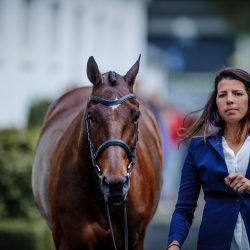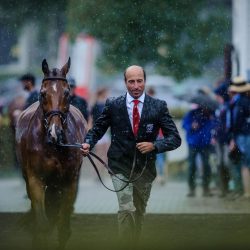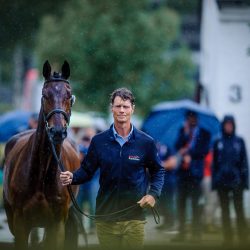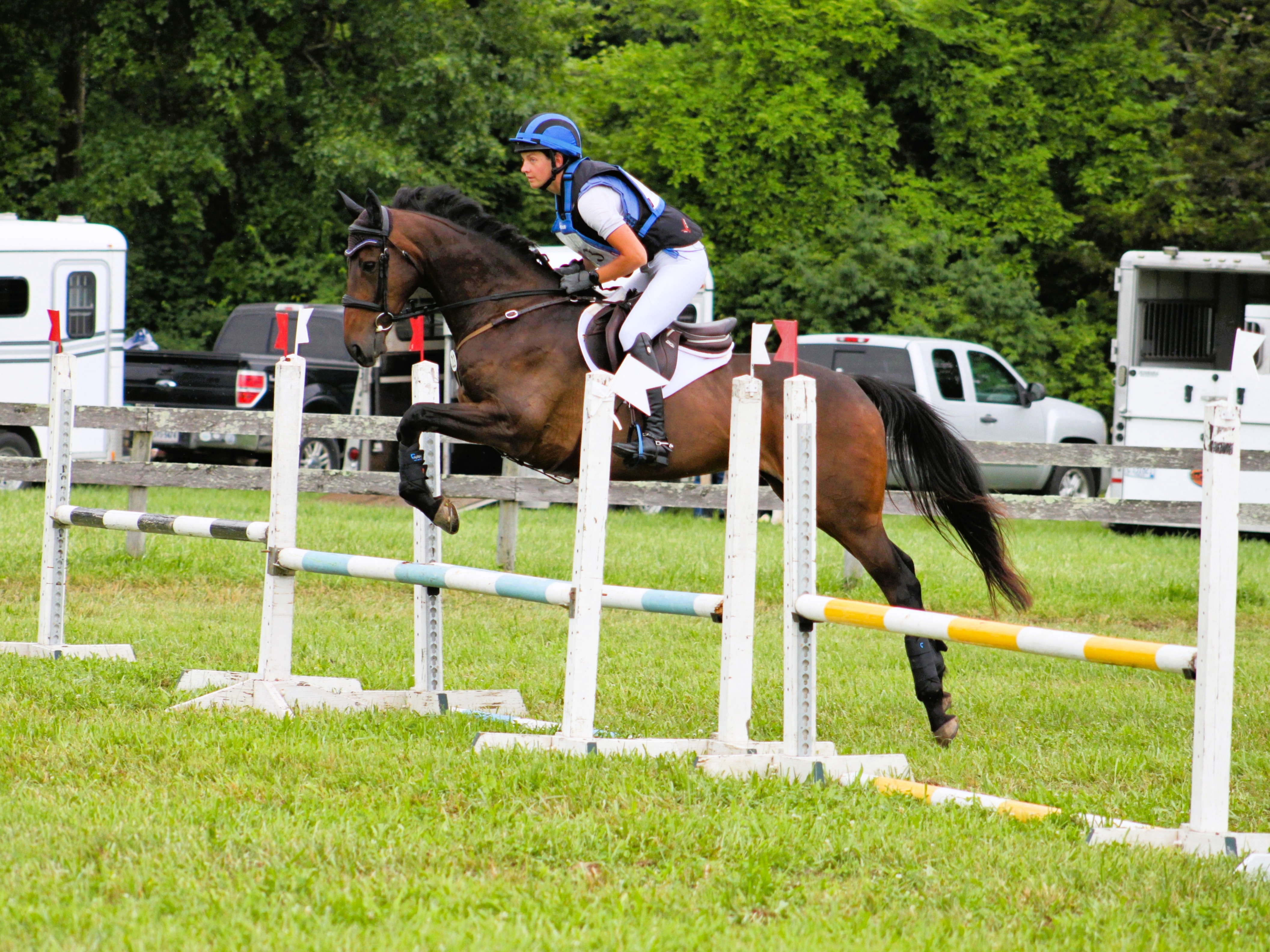
Michael Jung’s Kentucky champion fischerChipmunk FRH delivers a 22.2 to take an unsurprising first-phase lead. Photo by Tilly Berendt.
In perhaps the least surprising moment of 2022’s sporting calendar so far, Michael Jung has taken a decisive first-phase lead at Aachen with his Kentucky champion, fischerChipmunk FRH. The pair scored an exceptional 22.2 in a faultless test, putting them 3.6 penalties ahead going into this afternoon’s showjumping.
“Everything was a highlight — he was nice to ride, relaxed, and positive,” says Michi, who brought the horse back into work just a couple of weeks ago. “He’s just done a bit of training and hacking — it’s all easygoing, but he’s on very good form.”

Will Coleman and ten-year-old Chin Tonic HS impress again on German soil, sitting second after dressage. Photo by Tilly Berendt.
After an impressive effort at Luhmühlen’s CCI4*-S two weeks ago, where he led the dressage and ultimately finished eleventh in a top-class field, Will Coleman‘s Chin Tonic HS is back with a bang: he sits second on a 25.8 after an expressive, fluid test that didn’t at all betray his innate inexperience.
“He still feels like a kid at his first state fair — he goes in there and he’s like, ‘wow, look at this!’,” says Will. “He doesn’t do anything wrong, but you sort of feel that you’re not really attacking the test. But I think we’ll get there, and for a young horse on his first big excursion he’s been great, and we’re really, really happy with him.”
Will’s sojourn with the exciting gelding has been part of a mission to give him valuable experience that’ll hopefully set him up well as a championship horse for the future.
“It’s taken a bit out of him, and I do feel like he’s a little bit not totally himself, but he’s got a great brain in a lot of ways and he’s an honest, genuine horse, so even when he feels a little bit like he’s had some of the spark taken out of him, it’s been really nice to see that he’s still answered the bell to this point. It’s all part of the process, and that’s really why we brought him over and are doing this — it’s to see how he copes and see where we can support him better for the future. It’s a fact-finding mission, but I think he’s well worth the investment.”

2021 champion Off The Record betters last year’s test – despite errors in the canter work. Photo by Tilly Berendt.
Will heads into the second phase with an impressive two horses in the top ten: his 2021 Aachen winner, Off The Record, posted a 28.5 to better last year’s score by 1.2 penalties, which was enough to put him in ninth place at the end of this phase. That’s two places up from where he started last year, despite mistakes in the canter work, proving that the overall picture has undeniably improved – helped along, perhaps, by ‘Timmy’s’ recent swap to a double bridle.
“It’s a really strong field — like, an Olympic quality field, and so anyone who’s put in a test that’s in the top ten should be fairly happy,” says Will. “There are little things that you always think can be better, but my horse has tried really hard and although we had a couple of little unfortunate mistakes at the end, it’s a three-phase competition, so we have to put it behind us and just look ahead.”
The uncharacteristic mistakes included a swap to the left lead coming out of the corner at the start of the canter work, and another swap after the extended canter: “that was maybe a little bit of tension creeping in, or maybe when he made the first mistake it rattled him a little bit. He does try in his own way, and it’s one of those things where I don’t know if I can explain why it happened, but it’s not catastrophic. I do think he’s a bit farther along, and I was really happy with the test, but I’m just bummed for him more than anything — I probably could have done something a little better in there, and I’m not going to blame him for that. Hopefully I can make it up to him in the other phases!”
Those other phases — which begin with this evening’s showjumping in the main arena and conclude with tomorrow morning’s technical, intense cross-country course, should certainly fill Will with some confidence, because he’s sitting on a horse that won this competition last year with two clear rounds and just 0.8 time penalties across the country. But ever the pragmatist, Will’s determined to keep looking forward, rather than dwelling on prior successes.
“I’m just trying to keep things in a good perspective,” he says. “It’s a different year, and even the horses are different than they were last year. The course is different; everything is different. We’re back at Aachen, and that’s the only thing that’s the same, so I’m trying not to have a whole lot of memory of last year — I’m just trying to focus on what’s in front of us.”

Tom McEwen and Toledo de Kerser look on super form, taking provisional third after the first phase. Photo by Tilly Berendt.
Another rider who’s committed to looking forward — though for rather different reasons — is Great Britain’s Tom McEwen, who sits third on 26.4 with his Tokyo individual silver medallist Toledo de Kerser. They come to Aachen after a tough spring for the rider, whose Badminton bid with the Selle Français ended with a shock fall near the end of the course, and who has since had similarly odd blips at Bramham, where his ride Dream Big fell in the final line while showjumping for a top ten placing, and at Luhmühlen, where a dog on course caused his horse Bob Chaplin to spook and fall at the penultimate fence on cross-country.
But Tom, who’s a stalwart member of the British team, is wise beyond his 31 years, and he’s aware that bad luck — just like good — tends to come all at once, and all you can do is keep on working through it. Already, he’s got plenty to be excited about: the walk, which has been something of an Achilles’ heel for the gelding, looked at its best in today’s test, which was packed to the hilt with quality.
“That walk was an 8 for him, comparable to everyone else, and I’m really pleased,” says Tom. The one expensive blip came in the first flying change, which earned them 4.5s from the judges at C and E.
“It’s a shame, because that’s been nailed all the time outside — but I didn’t quite have him connected coming out of the corner,” he explains. “The rest, though, felt really nice — really clear, really supple, and really forward.”
Tom, whose bid for World Championships selection likely hinges on a good run here this week, didn’t actually rely on an arena-based game plan for improving the details, including that walk — instead, it comes down in large part to backing off the now-15-year-old.
“All the pieces have connected on their own, to a degree, and we’ve really worked him out and had a good set plan here. He’s getting older, and he doesn’t need to work half as much as he used to. Our prep probably wasn’t perfect; he had a run at Farley last weekend just to give him a run after Badminton, and normally I wouldn’t do that, so he’d probably have a bit more punch to his trot. But I couldn’t be happier; he tried his heart out and was brilliant.”

World Champions Ros Canter and Allstar B add a karaoke element to their test, but still deliver a competitive performance. Photo by Tilly Berendt.
World Champions Ros Canter and Allstar B have also scaled back the schooling to great effect this year, and although we got ‘Allstar B: The Musical’ in the arena today, the pair earned themselves a very good score of 26.5 to take fourth place going into showjumping.
“Albie’s best friend Zenshera is here this week to do the Ride & Drive class, and they’ve got particularly attached to each other since they’ve been here,” says Ros of Albie’s near-constant whinnying throughout the test. “He actually hadn’t whinnied at all until he started his test, but I think he was amazing, actually, because he managed to whinny and only have half his mind on the job and still pull out one of his best tests. Most horses, if they were whinnying and distracted like him, would jog in the walk or something, or their heads would move, and he really felt no different than usual. I was over the moon with how he went — I think this year, I’m probably getting better and better at riding him.”
Since the European Championships last September, Ros has taken all of Albie’s schooling out of the arena, choosing instead to hack him extensively and let him mentally and physically unwind – and that method is still serving her well, particularly as the seventeen-year-old gelding hasn’t long been back in work after his post-Badminton holidays.
“He hasn’t done an awful lot — he hacked for a couple of weeks, and then went in the arena twice and jumped a few times and then he’s come here,” she says.
The rangy gelding is a consummate long-format specialist and excels over tracks such as Badminton and Burghley, so while Ros concedes that Aachen might not be his ideal event, she was keen not to pass up an opportunity to compete at the extraordinary venue for the first time: “I’ve never been and I really wanted to come, and he was probably the only one that fitted in, schedule wise. I don’t run him at many four-shorts, because he’s a better long format horse, but I’d kind of run out of options — it probably isn’t his ideal track, but he’s such an old pro and we’ll give it our best shot.”

Tim Price and Falco dance to a spot in the top five after the first phase. Photo by Tilly Berendt.
2021 Pau winners Tim Price and Falco looked on great form to take provisional fifth place on a score of 26.8, while sixth place is held for now by William Fox-Pitt, whose Little Fire could be on track for Pratoni selection with a competitive run here. Their 27.2 just betters the score they earned at Badminton, where they finished thirteenth this spring.

William Fox-Pitt and Little Fire contain the spark for a 27.2. Photo by Tilly Berendt.
The home nation holds seventh and eighth place, with Sophie Leube and Jadore Moi taking the former on 27.5 after rerouting from Luhmühlen CCI5*, where they retired at the first water after an exuberant entrance and a subsequent loss of reins meant they were well off their line for the next element, prompting Sophie to make the call to save her Boekelo winner for another day. Behind them on 28.3 is Sandra Auffarth with her Tokyo partner Viamant du Matz, who produced a test of improved fluency from their Luhmühlen effort, which saw them earn a 31. The top ten is rounded out by young Frenchman Stephane Landois, who earned a 28.6 with Chaman Dumontceau.

Buck Davidson and Carlevo go sub-30 despite it being Carlevo’s ‘worst test’, per Buck. Photo by Tilly Berendt.
A broken-footed Buck Davidson and Carlevo sit fifteenth on a 29.9 despite a mistake in the first canter strike-off, which saw them pick up the wrong lead for a stride: “It’s really irritating; I don’t think I’ve ever missed a canter strike off with him, even in practice — but sometimes you’re the windshield and sometimes you’re the bug, right? There’s two more phases, though, and I can’t fault him. I’ll take it on the chin and be better next time, for sure.”

Meghan O’Donoghue and Palm Crescent fly the flag for ex-racehorses. Photo by Tilly Berendt.
Aachen debutantes Meghan O’Donoghue and Palm Crescent, who were eleventh at Kentucky this spring, go into showjumping in 26th place on a very respectable 31.6.
“I was thrilled with him; he tried really, really hard — and we’re here for the team, most importantly, so I hope that we can contribute to that,” says Meghan. “He’s an American Thoroughbred, and he raced, so I’m definitely also trying to show that they still have a place in the sport.”

Sydney Elliott and QC Diamantaire far eclipse their previous Aachen test, posting a 32.4. Photo by Tilly Berendt.
Sydney Elliott and QC Diamantaire sit 28th on a 32.4, which doesn’t quite rival the competitive scores they’ve earned at venues such as Boekelo, but is a considerable improvement over last year’s test here, which saw the leggy gelding boil over in the ring. Part of Sydney’s plan of action? Arriving to Europe early, so she could get a couple of weeks of training in at the Belgian base of Lara de Liedekerke Meier and Kai Steffen Meier.
“We really wanted to let him settle, and Kai has been helping us keep that theme going from Boekelo,” says Sydney. “He’s very fragile, and a bit of a delicate flower, so he likes to get settled in — and Kai and Lara are basically family now, so it’s hard to even think about leaving!”
We’re heading straight into showjumping now, so stay tuned for more updates from Aachen. Go Eventing!

The top ten after dressage at CHIO Aachen.
CHIO Aachen Links: Website|Entries|Live Scoring|Live Stream|EN’s Coverage|EN’s Insta|EN’s Twitter

































 Events
Events




















































